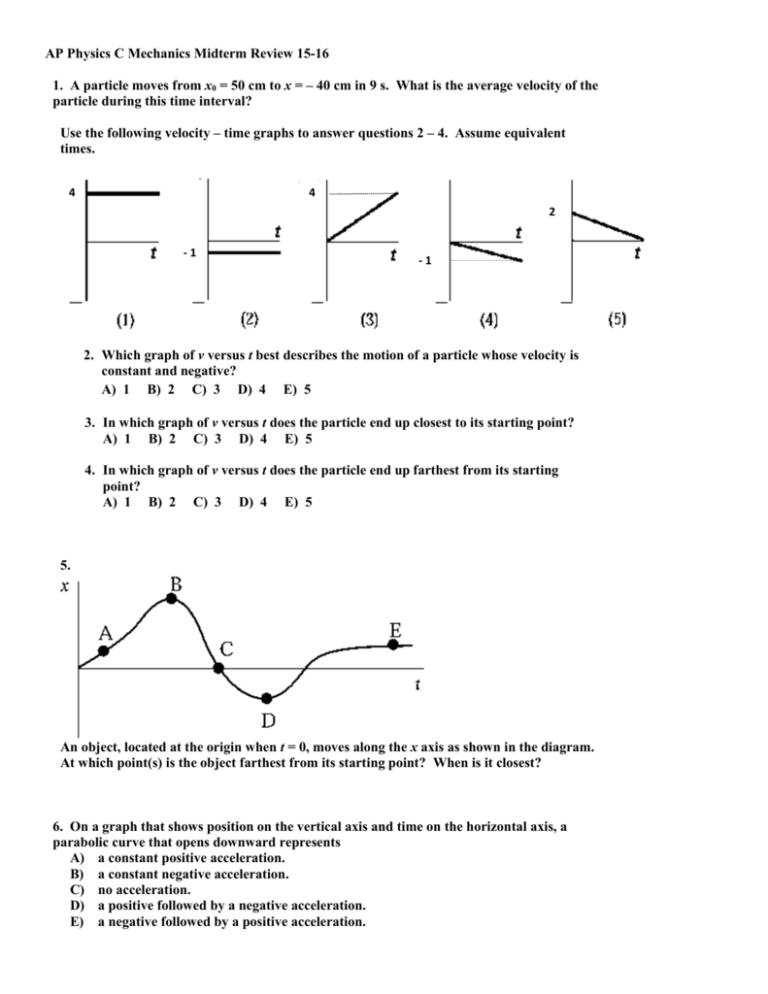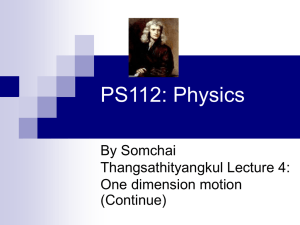File
advertisement

AP Physics C Mechanics Midterm Review 15-16 1. A particle moves from x0 = 50 cm to x = – 40 cm in 9 s. What is the average velocity of the particle during this time interval? Use the following velocity – time graphs to answer questions 2 – 4. Assume equivalent times. 4 4 2 -1 -1 2. Which graph of v versus t best describes the motion of a particle whose velocity is constant and negative? A) 1 B) 2 C) 3 D) 4 E) 5 3. In which graph of v versus t does the particle end up closest to its starting point? A) 1 B) 2 C) 3 D) 4 E) 5 4. In which graph of v versus t does the particle end up farthest from its starting point? A) 1 B) 2 C) 3 D) 4 E) 5 5. An object, located at the origin when t = 0, moves along the x axis as shown in the diagram. At which point(s) is the object farthest from its starting point? When is it closest? 6. On a graph that shows position on the vertical axis and time on the horizontal axis, a parabolic curve that opens downward represents A) a constant positive acceleration. B) a constant negative acceleration. C) no acceleration. D) a positive followed by a negative acceleration. E) a negative followed by a positive acceleration. 7. The displacement of an object for a round trip between two locations A) is always greater than zero. B) is always less than zero. C) is zero. D) can be greater than or less than but not equal to zero. E) can have any value. 8. A car decelerates uniformly from a velocity of 40 km/h to 5 km/h in one minute. Which graph best describes the motion of the car? A) 1 B) 2 C) 3 D) 4 E) 5 9. Two of the graphs shown are INCORRECT for a particle undergoing one-dimensional motion with constant acceleration. They are A) 1 and 2 B) 2 and 3 C) 3 and 4 D) 4 and 5 E) 1 and 5 10. An object is at x = –2.0 m and has a velocity of –5.0 m/s. It is observed to be slowing down. Its acceleration is A) positive. B) negative. C) zero. D) negative until the object stops and then positive. E) impossible to determine based on the information provided. 11. The graph is a plot of velocity versus time for a moving object during a particular time interval. Which of the following statements is correct? A) The acceleration of the object is zero. B) The acceleration of the object is constant. C) The acceleration of the object is positive and increasing in magnitude. D) The acceleration of the object is negative and decreasing in magnitude. E) The acceleration of the object is positive and decreasing in magnitude. 12. The vector in the figure that could represent → − → is vector number: A) 1 B) 2 C) 3 D) 4 𝑩 E) 5 𝑨 13. A ball is thrown horizontally from a cliff with a velocity v 0. A graph of the acceleration of the ball versus the distance fallen could be represented by curve A) 1 B) 2 C) 3 D) 4 E) 5 Use the following to answer questions 14 – 15: 14. The figure represents the parabolic trajectory of a ball going from A to E in earth gravity but without air resistance. What is the direction of the acceleration at point B? C? D? 15. The figure represents the parabolic trajectory of a ball going from A to E in earth gravity but without air resistance. At point C the velocity of the ball is A) a maximum and is directed to the right. D) a minimum and is directed to the right. B) directed to the left. E) zero. C) a maximum. 16. A) B) C) D) E) A body moves with constant speed in a straight line. Which of the following must be true? No force acts on the body. A single constant force acts on the body in the direction of motion. A single constant force acts on the body in the direction opposite to the motion. A net force of zero acts on the body. A constant net force acts on the body in the direction of motion. 17. A force F produces an acceleration a on an object of mass m. A force 3F is exerted on a second object, and an acceleration 8a results. What is the mass of the second object? A) (8/3)m B) 9m C) 24m D) (3/8)m E) 3m 18. A person of weight w is in an upward-moving elevator when the cable suddenly breaks. What is the person's apparent weight immediately after the elevator starts to fall? A) zero B) greater than w C) less than w D) 9.81w E) w 19. If a force F is required to extend a spring a distance 7y, how far will it be extended by force 4F? 20. Which of the following free-body diagrams most closely represents the block sliding down a frictionless inclined plane? What if it was moving at constant velocity? Under which circumstances would it accelerate? Under which circumstances would it be considered to be in equilibrium? A) 1 B) 2 C) 3 D) 4 E) 5 21. A 15-kg block sitting on a smooth table is connected to a free-hanging 5-kg mass by a stretchless, massless cord that passes over a small frictionless pulley. The acceleration of the two-block system is A) equal to g. B) half of g. C) one-third of g. D) one-fourth of g. E) zero. 22. Three boxes are connected by stretchless strings and are pulled by a force F as shown in the figure. Which box has the greatest acceleration? A) A B) B C) C D) They all have the same acceleration. E) The accelerations of B and C are greater than that of A. 23. A block of mass m is at rest on an inclined plane that makes an angle of 30º with the horizontal, as shown in the figure. Which of the following statements about the force of static friction is true? A) fs > mg D) fs < mg sin 30º B) fs > mg cos 30º None of these statements is true. E) C) fs = mg cos 30º 24. A block of mass m is pulled in the direction shown in the figure across a rough surface at a constant velocity. The magnitude of the frictional force is 25. A car going around a curve of radius R at a speed V experiences a centripetal acceleration ac. What is its acceleration if it goes around a curve of radius 3R at a speed of 2V? A) (2/3)ac B) (4/3)ac C) (2/9)ac D) (9/2)ac E) (3/2)ac 26. A body of mass m slides a distance d along a horizontal surface. How much work is done by gravity? What if it were released from a height of h? 27. Which of the following statements is true? A) The kinetic and potential energies of an object must always be positive quantities. B) The kinetic and potential energies of an object must always be negative quantities. C) Kinetic energy can be negative but potential energy cannot. D) Potential energy can be negative but kinetic energy cannot. E) None of these statements is true. 28. The work done by a conservative force between two points is A) always positive. B) always dependent upon the time. C) always independent of the path. D) zero. E) never completely recoverable. 29. A body of weight w is in free fall near the surface of the earth. What force does the body exert on the earth? A) w B) greater than w C) less than w D) 9.81w E) zero 30. A man riding in an elevator has an apparent weight greater than his actual weight. Which one of the following statements could be true? A. B. C. D. E. The elevator moves upward with constant speed. The elevator moves downward with constant speed. The elevator moves upward with decreasing speed. The elevator moves downward with decreasing speed. The elevator moves downward with increasing speed. 31. Which of the following statements is NOT true about friction? A) µk is less than µs. B) µk is independent of the relative speed of the surfaces in the range of about 1 cm/s to several meters per second. C) µk depends on the relative speed of the surfaces at speeds over several meters per second. D) The coefficients of friction depend on the nature of the surfaces. E) The force of static friction depends on the area of contact between the two surfaces. 32. The system in the figure is moving with constant speed v to the right on a stationary ramp. The system will accelerate to the right if A) angle is increased. B) angle is increased. C) the coefficient of friction µk for surface A is increased. D) the coefficient of friction µk for surface B is increased. E) the normal force on block 2 is increased. 33. When will this system remain in equilibrium? 34. If vector A = –3i + 2j and a vector B = 2i – 3j, the DOT product is 35. What is the angle between the vectors A = –2i + 3j and B = 4i – 5j? Does A do any work on B? In what way? 36. Power P is required to do work W in time interval t. What power is required to do work 5W in time interval 3t? 37. A woman runs up a flight of stairs. The gain in her gravitational potential energy is U. If she runs up the same stairs with twice the speed, what is her gain in potential energy? 38. A particle is moving uniformly in a circle with radius 50 cm. The linear speed of the particle is 10 cm/s. The acceleration of the particle has a magnitude of…? How much work is done by the centripetal force? 39. A car experiences both a centripetal and a tangential acceleration. For which of the following would this be true? A) It is going around a curve at a constant speed. B) It is going around a curve and slowing down. C) It is going along a straight road at a constant speed. D) It is going along a straight road and increasing its speed. E) It is going along a straight road and decreasing its speed. 40. A 2-kg pendulum bob is attached to a string of length 3m. The bob is struck horizontally, giving it an initial horizontal velocity of 4.5 m/s. When the bob makes a 300 angle with the vertical, a) What is its speed? b) What is its potential energy? c) What is the tension in the string? d) At what angle from the vertical will it reach its maximum height? (See #36) . 41. A 2.4 kg block is dropped onto a spring with a spring constant of 3955 N/m from a height of 5.0 m. When the block is momentarily at rest, the spring compresses by 25 cm. Find the speed of the block when the compression of the spring is 15 cm. (See #26)








